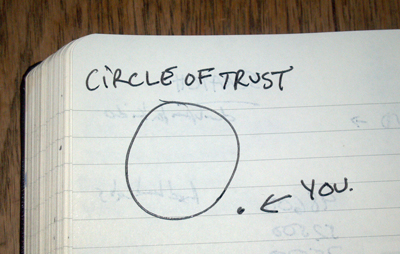Building Trust in an Instant World
Building Trust in an Instant World
This morning I was roused from my slumber by a persistent low-level buzzing. Someone’s phone was sitting out and in the early, early morning silence the vibrating ringer was literally making the house buzz. It turns out that my son left his phone on the fireplace mantle, which lies below my room. What was the urgent message? A simple text.
“Nah”
It got me thinking about youth, communication, social media, our “instant world” and trust. After a couple cups of coffee, I’m inspired to share some thoughts on how to build trust in an instant world. (as well as reminding me to be thankful for trade routes but that’s another story)
“The more things change, the more they stay the same” is a tired old trope but it works. The tools we use to communicate have changed and will change, but the fundamentals of communicating effectively remain constant. Consistency, finding mutual benefits, listening and focusing on issues/not being blinded by personalities still drives the cornerstone of relationships: Trust.
I’ll use those fundamentals to outline a few points about how to build trust online.
Consistency. A strong building needs a solid foundation, right? (my aunt used to tell me this as she looked at my giant feet as a youth – “don’t worry, you’ll grow into them”) Consistency is the foundation for trust. I’m not talking about “every day he does ‘x'”, but a more nuanced “every day his actions align with our shared values” kind of thing. In our instant world, with it’s increasing storage capacity and search-ability might make it harder to hide our inconsistencies, but on the flip side it helps us draw a line and connection points.
At the risk of sounding flighty, the more in tune you are with your own values and the more those values shape your actions, the easier it is to build instant trust. “This is who I am . . . and look back, it’s basically who I have been over time,” helps with Consistency, and helps build trust. Often in an instant but not by itself.
Finding mutual benefits. Tagging along with consistency in building trust, is the finding of mutual benefits. We’re societal creatures, giving up some of our individualism for the greater good. We do this because the sum is greater than the parts, right? We find it mutually beneficial. It’s good for you and it’s good for me. I refer to the Law of Reciprocity often because it can be abused but when it’s used for the benefit of both parties, something bigger starts to take shape. In our increasingly instant world, the struggle is in how to do that. Again, the “memory” of mutual benefits that these new communication tools give us can bring Trust faster or take it away.
Let me address the “taking it away” concept here a bit. You can’t trust everybody and you can’t expect everyone to trust you. We all bring our own set of experiences and expectations to relationships and part of that is people not trusting you. In the past we may have never known how someone feels, but in the instant world, the transparent world, you tend to find out how people feel. My advice is to stay true to your values, understanding that not everyone shares those values and will not be open to your version of mutual benefits.
Consider this a virtual “pat on the back” – it’s okay.
Listening. Just looking at this word makes me think of Fraser. “I’m listening.” I have gone on about the “iceberg effect of communication” and in our instant world, nothing’s changed. Emoticons, abbreviations, Vine videos, are all attempts at improving our communication and building trust. Listening has always been a part of that. Face to face we have all sorts of checks and balances that help us understand one another. The telephone took some of those tools away, forcing us to be better with language and now we’re forced to try and listen in 140 character bursts.
Want to build trust? Turn those 140 characters into listening phrases. The same ones we had to learn on the phone. “Wait, what do you mean by that?” “Explain that again?” “Are you saying. . .?” I know, it’s awkward but just because we can instantly communicate doesn’t mean we instantly understand. Listening is trying to understand. Simply keeping that in mind, not jumping to conclusions, helps with trust.
Focusing on Issues. This falls into the “jumping to conclusions” box. Effective communication has always involved focusing on the message and not the messenger. Personality quirks, bad grammar, low light levels, public places. . .all little things that distract me from what you’re saying. I can focus on that, or I can focus on the message. Focus on the issue.
Excelling at focusing on issues fosters trust. “He understands” gets you further towards effective communication than “he hates it when i don’t use caps”. That said, if you’re seeking to be understood, it helps to know how the person you’re trying to work with likes to be communicated with.
Does that help? “What has happened, will happen” is another favorite of mine. The process of effective communication and the steps involved in building trust are constants. They’re universal even as the tools we use to communicate change. If it worked in the past, it will work in the future so don’t be distracted by the Instant World. The principles of Building Trust will endure.
Good stuff.



